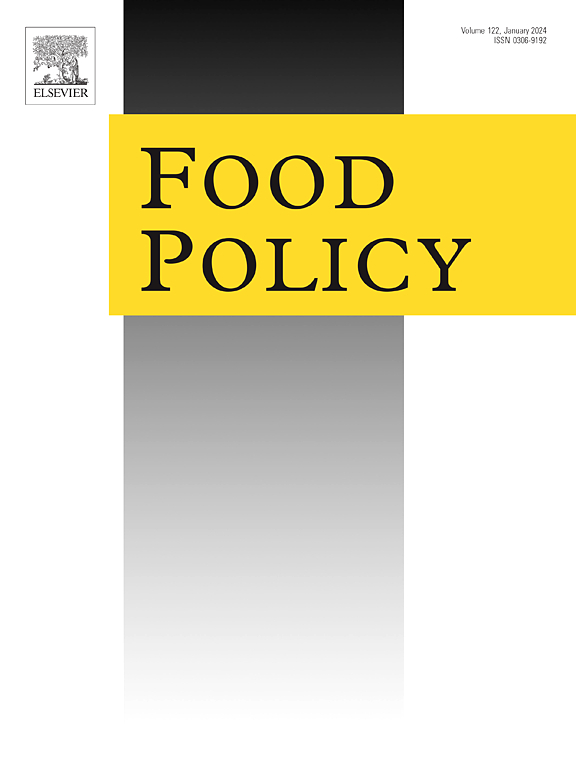Assessing the social risk of high-protein food alternatives using the social life cycle assessment
IF 6
1区 经济学
Q1 AGRICULTURAL ECONOMICS & POLICY
引用次数: 0
Abstract
The rapidly increasing global population presents important challenges in ensuring adequate and nutritious food, especially when accounting for the associated social and environmental impacts. This paper investigates the social risks associated with different protein sources, focusing on animal-based and plant-based options. Specifically, it assesses the risk of four main protein products in the Spanish market: meat, dairy, fish, and agricultural products.
Social risks are evaluated using the Social Life Cycle Assessment methodology. In this study, social risks are assessed for four social stakeholder categories: workers, local community, value chain, and society using the Product Social Impact Life Cycle Assessment database. The functional unit is based on the daily recommended protein intake for human consuption, considering the protein content of each product, with products classified into four main categories: meat, dairy products, agricultural products (plant-based), and fish and other fishing products (seafoods). To make a final comparison the results were compared to the results of the social risks assessment of 1 kg of the same products.
Based on daily requirements intake of functional unit, the highest social risks are observed in the workers and local community stakeholder category. For workers, the most significant risks are seen in fair salary, non-fatal accidents, and trade unionism indicators, with fishing and other fishing products having the highest impacts. For the local community, biomass consumption indicator has the highest risk, while fishing products show the highest risk among all protein sources. Using different functional units can significantly change the results. When assessing social risks based on 1 kg of protein product produced by the sector, all four protein groups exhibit similar social risk values. The lowest social risk is observed in meat production on society (21 %), fish and other fishing products on the value chain (21 %), and agricultural products on workers (21 %). In contrast, the highest social risk is associated with the manufacturing of dairy products, affecting the local community (29 %). However, when assessing social risks based on daily recommended protein intake, the risks vary significantly. The lowest risk is observed for agricultural products on workers (14 %), while the highest risk is associated with fish and other fishing products on society (42 %).
The findings reveal that different functional units can significantly alter the interpretation of social risks, underscoring the need for careful consideration in comparative assessments. This study highlights the critical role of social risk assessments in supporting sustainable food systems and informing policy and consumer decisions beyond nutritional and environmental aspects.
利用社会生命周期评估法评估高蛋白食品替代品的社会风险
全球人口的迅速增长对确保充足和有营养的食物提出了重大挑战,特别是在考虑到相关的社会和环境影响时。本文调查了与不同蛋白质来源相关的社会风险,重点是动物性和植物性选择。具体来说,它评估了西班牙市场上四种主要蛋白质产品的风险:肉类、乳制品、鱼类和农产品。使用社会生命周期评估方法评估社会风险。在本研究中,使用产品社会影响生命周期评估数据库,评估了四个社会利益相关者类别的社会风险:工人,当地社区,价值链和社会。功能单位是基于人类每日推荐的蛋白质摄入量,考虑到每种产品的蛋白质含量,产品分为四大类:肉类、乳制品、农产品(植物性)、鱼类和其他渔业产品(海产品)。为了进行最后的比较,将结果与1公斤相同产品的社会风险评估结果进行了比较。从功能单元的日需要量来看,工人和当地社区利益相关者类别的社会风险最高。对工人来说,最大的风险体现在工资公平、非致命事故和工会指标方面,其中渔业和其他渔业产品受到的影响最大。对当地社区而言,生物量消耗指标风险最高,而渔业产品在所有蛋白质来源中风险最高。使用不同的功能单元可以显著改变结果。在以该部门生产的1公斤蛋白质产品为基础评估社会风险时,所有四个蛋白质组都显示出相似的社会风险值。社会风险最低的是肉类生产对社会的影响(21%),价值链上的鱼和其他渔业产品(21%),以及农产品对工人的影响(21%)。相比之下,最高的社会风险与乳制品生产有关,影响当地社区(29%)。然而,当基于每日推荐蛋白质摄入量评估社会风险时,风险差异很大。农业产品对工人的风险最低(14%),而鱼类和其他渔业产品对社会的风险最高(42%)。研究结果表明,不同的功能单位可以显著改变对社会风险的解释,强调在比较评估中需要仔细考虑。这项研究强调了社会风险评估在支持可持续粮食系统以及在营养和环境方面以外为政策和消费者决策提供信息方面的关键作用。
本文章由计算机程序翻译,如有差异,请以英文原文为准。
求助全文
约1分钟内获得全文
求助全文
来源期刊

Food Policy
管理科学-农业经济与政策
CiteScore
11.40
自引率
4.60%
发文量
128
审稿时长
62 days
期刊介绍:
Food Policy is a multidisciplinary journal publishing original research and novel evidence on issues in the formulation, implementation, and evaluation of policies for the food sector in developing, transition, and advanced economies.
Our main focus is on the economic and social aspect of food policy, and we prioritize empirical studies informing international food policy debates. Provided that articles make a clear and explicit contribution to food policy debates of international interest, we consider papers from any of the social sciences. Papers from other disciplines (e.g., law) will be considered only if they provide a key policy contribution, and are written in a style which is accessible to a social science readership.
 求助内容:
求助内容: 应助结果提醒方式:
应助结果提醒方式:


